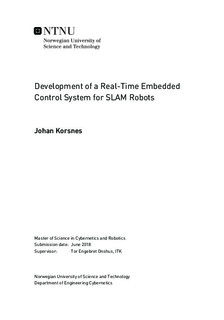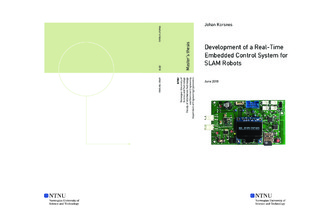| dc.description.abstract | This thesis encompasses all phases in the development of a real-time embedded control system designed for simultaneous localization and mapping (SLAM) robots. This work includes system design, schematic capture, printed circuit board (PCB) design, assembly using precision soldering, and embedded software development. A template application running on a real-time operating system (RTOS) has been set up with device drivers. Real-time aware debug facilities have been implemented, giving complete insight into the RTOS' behavior.
A set of specifications and requirements have been derived for the new control system, ensuring compatibility with the equipment used on current SLAM robots. The nRF52 System-on-Chip (SoC) used has been thoroughly assessed. New functionality has been introduced, such as an onboard display and a microSD slot for portable storage. A two-stage power supply has been designed with a focus on efficiency and a stable output voltage.
Complete schematic capture of the electrical control system has been performed, for which a four-layer PCB layout has been designed. While the fabrication of the PCB itself is outsourced to an external fabricator, the assembly process is performed as part of the thesis work. This process involves different precision soldering techniques and electrical verification.
A low-cost development environment is set up, where the development kit used for flash programming and debugging is the only expense. The integrated development environment used, Segger Embedded Studio, and the advanced real-time aware tracing software used, Tracealyzer, are both available in educational licenses free of charge. Both a set of drivers and a template application incorporating these, have been developed. The template application is set up to showcase different synchronization mechanisms, and to serve as a template for future work.
The new control system features a robust and unified single PCB design, something which addresses concerns raised about the hardware reliability with previous control systems. The new development environment features modern real-time aware debugging facilities, improving upon the inadequacies in previous control systems. With a template application with drivers set up, the control system is viable for implementation in a SLAM robot. | |

